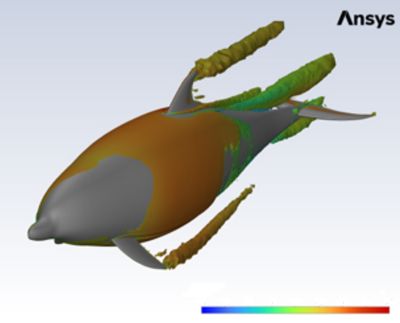-
United States -
United Kingdom -
India -
France -
Deutschland -
Italia -
日本 -
대한민국 -
中国 -
台灣
-
Ansys si impegna a fare in modo che gli studenti di oggi abbiano successo, fornendogli il software gratuito di simulazione ingegneristica.
-
Ansys si impegna a fare in modo che gli studenti di oggi abbiano successo, fornendogli il software gratuito di simulazione ingegneristica.
-
Ansys si impegna a fare in modo che gli studenti di oggi abbiano successo, fornendogli il software gratuito di simulazione ingegneristica.
-
Contattaci -
Opportunità di lavoro -
Studenti e Accademici -
Per Stati Uniti e Canada
+1 844.462.6797

Marine biology researchers in Japan are using Ansys simulation to answer an age-old question: What is the function of fins in aquatic mammals like dolphins and whales? Using computational fluid dynamics (CFD), graduate student Taro Okamura of the Graduate School of Environmental Studies at Nagoya University is leading research on the evolutionary process of how and why cetaceans acquired their fin shapes.
Under the supervision of Nagoya professor Ken Yoda, Ph.D., and with access to Ansys Fluent fluid simulation software through the Ansys Academic Program, Okamura uses CFD to understand how the diversity of cetacean fin morphology — its form, position, and size — relates to hydrodynamics.
While traditional morphology research involves measuring and comparing animal shapes, CFD enables him to better analyze cetacean fin morphology, which involves substantial diversity, from the differences in fin shape among cetaceans to the functionality of those shapes in a fluid environment. Although CFD can appear challenging for simulation novices, he finds the software to be user-friendly and invaluable for his research.
Taking CFD Into the Field
Okamura has led the research for the past four years in connection with his graduate project. While most of the research and analysis is conducted in a laboratory at Nagoya University, the team also conducts fieldwork.
Cetaceans live in waters throughout Japan, and hundreds of strandings occur on beaches each year. According to the National Oceanic and Atmospheric Administration (NOAA) Fisheries, cetaceans are deemed stranded when they are found dead either on the beach or floating in water or when found alive on the beach but unable to return to water. The Associated Press reports that more than 300 whale strandings alone are reported annually across Japan. Working with aquariums and museums in the country, Okamura and the team visit stranding sites to perform 3D scans and anatomical measurements to create 3D models for hydrodynamic simulation.

Graduate student Taro Okamura of the Graduate School of Environmental Studies at Nagoya University
“Conventional morphology research is based on measuring and comparing the shapes of animals,” says Okamura. “The introduction of Fluent-based fluid simulation into morphology has been very helpful in that it allows us to express the absolute amount of functionality that shape provides. Specifically, we have been able to compare in absolute terms what is meant by differences in fin shape among species in cetaceans. We are also able to analyze extreme models that could not exist in nature, which allows us to capture the meaning of shapes more deeply.”
Although fins are a common structure in aquatic mammals, their evolutionary and developmental origin varies, says Okamura. It can be assumed that their morphology is the result of a complex combination of mechanistic, physiological, and behavioral functions, but it is also possible that a structure may have no function at all. By studying cetacean fins, he hopes to uncover more insight into overall fin function.

Professor Ken Yoda, Ph.D., of the Graduate School of Environmental Studies at Nagoya University

This image depicts the fins found on most cetaceans, including dolphins and whales.
Understanding Fin Shape and Function With Fluid Simulation
Okamura explains that cetaceans acquired three types of fins during the process of aquatic adaptation: pectoral fins, which are commonly called flippers; the upright dorsal fin found on the backs of many aquatic mammals; and the caudal fin, also called the tail fin or fluke. Although the dorsal fin has no joints and cannot move by itself, studies consistently recognize it as a posture stabilizer. However, the morphology of the dorsal fin varies significantly among species, prompting Okamura to ask: Does the dorsal fin perform the same stabilizer function in all cetaceans?
To explore these variations in shape, Okamura and the team create 3D models of species with considerably different fin morphologies and conduct hydrodynamic simulations. Generally, the purpose of fins includes propulsion, such as thrusting forward to help with swimming, and stability. However, the team’s research is exploring additional purposes.
“We approach our research with the hypothesis that animals have a superior form suited to their environment,” says Okamura. “However, our research with Ansys Fluent software is revealing that the fins of cetaceans we are studying seem to have a different function than we see or think they do. It is very interesting to discover that the shape and structure of an organism combines several functions and cannot be simply explained.”
CFD simulation has been particularly helpful in illustrating the fluid phenomena surrounding different fins and, in turn, providing a better understanding of fin purpose and function. Fluent software is widely recognized for its advanced physics modeling capabilities and used to model a range of fluid dynamics, including fluid flow, heat and mass transfer, and chemical reactions. Okamura especially appreciates the software’s meshing and parallel computation functions.
“The meshing function is very helpful in converting a complex, smooth model into a clean mesh that satisfies our wishes,” he says. “The parallel function also helps to reduce computation time.”
Okamura says the platform has a user-friendly interface, which democratizes simulation for non-experts. This then streamlines and enhances their research.
“I find Ansys Fluent simulation a useful tool for solving my research questions,” he says. “For us basic morphologists, learning a programming language is a hurdle — even more so for CFD simulations. I think Fluent software is very easy to use for beginners because it is not text-based but rather graphic-based, which is easy to understand. I am impressed to be able to see the invisible phenomenon of flow by using Fluent software, which has greatly broadened my research horizons.”

Okamura simulates a dolphin in Ansys Fluent fluid simulation software to analyze the velocity flow around the mammal’s fins.
Accessing Essential Simulation Tools
Seeing it as more than just a useful tool, Okamura deems the software necessary for completing his marine biology research.
“Now, CFD simulations using Ansys Fluent software serve as the basis of my doctoral research and are essential to my work,” he says.
In addition, he credits the Ansys Academic Program for increasing the affordability and accessibility of fluid simulation in the academic research community.
“At first, we were trying to conduct the analysis with other software,” says Okamura. “However, we were having trouble with high hurdles, such as meshing. We contacted Ansys Japan, and they told us about the Ansys Academic Program, which we joined. We are very pleased that this program makes it easier for graduate students to use the software.”
For more information and resources for educators, students, and researchers, visit Ansys Academic.
“Now, CFD simulations using Ansys Fluent software serve as the basis of my doctoral research and are essential to my work.”
— Taro Okamura, graduate student, Graduate School of Environmental Studies, Nagoya University
The Advantage Blog
The Ansys Advantage blog, featuring contributions from Ansys and other technology experts, keeps you updated on how Ansys simulation is powering innovation that drives human advancement.













